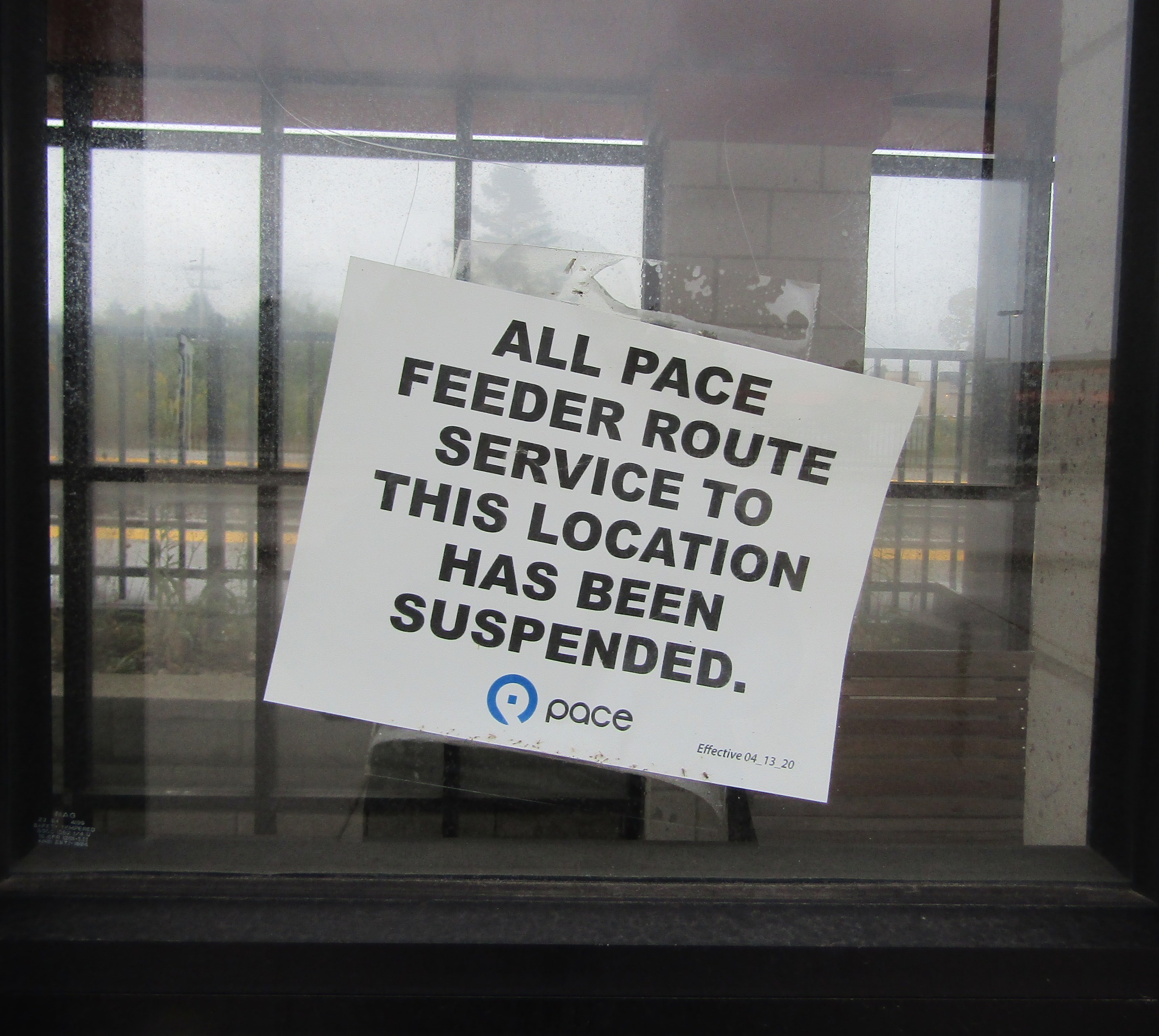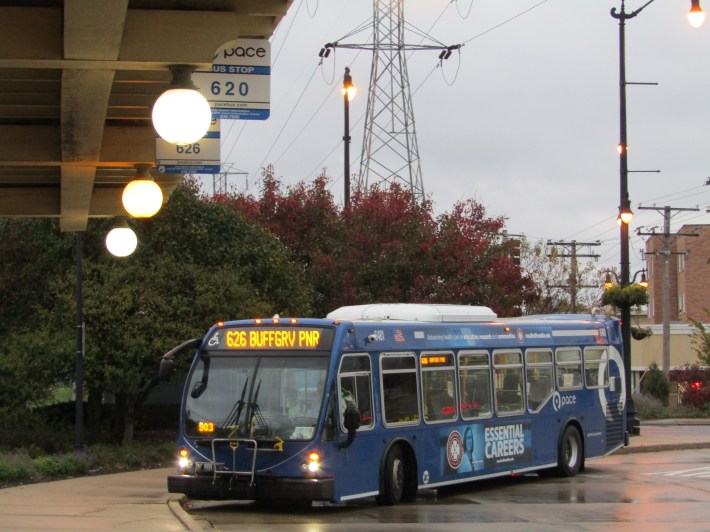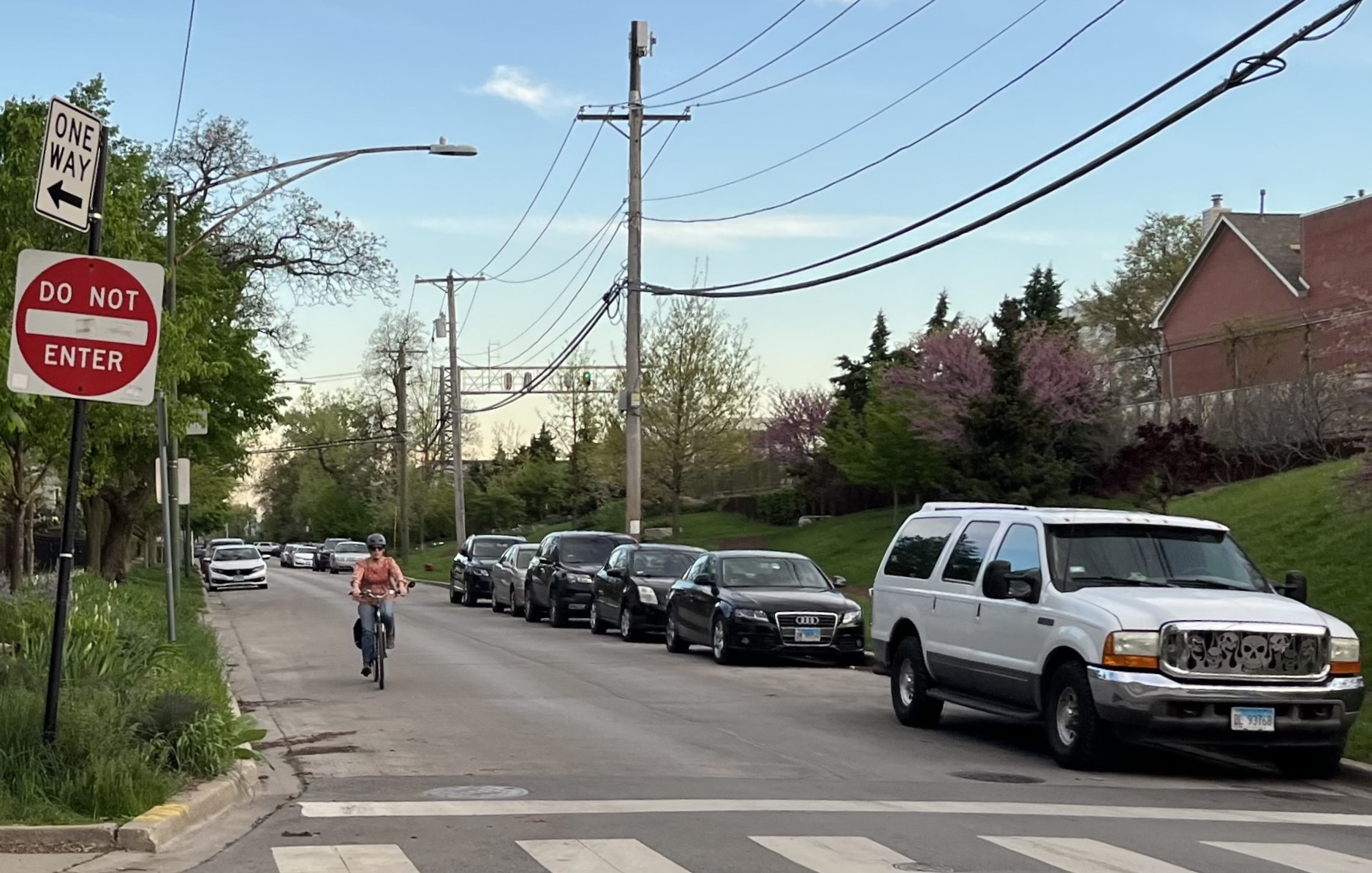Pace 2021 budget reflects the pandemic’s new normal
3:35 PM CDT on October 20, 2020

The bus turnaround at the Metra Milwaukee District North line’s Lake Cook Road station would normally be full of “shuttle bug” buses arriving to drop off commuters, but since the pandemic started it’s been down to one route. Photo: Igor Studenkov
If there are three words that can best sum up Pace’s plans for the upcoming year, they are “pandemic status quo.”
The suburban transit agency isn’t releasing its actual budget until the budget hearings, which kick off on October 23. But Pace already shared that the routes would stay exactly as they are, service suspensions and reductions and all. And Pace spokesperson Maggie Daly Skogsbakken answered a few questions about the transit agency’s general financial state.
The upcoming budget, which will be voted on in November, will officially extend the COVID cuts until further notice. With many companies still letting their employees work remotely, it’s only natural that most of the suspended services are feeder routes to Metra stations, reverse-commuter shuttles, express services from Metra and ’L’ stations, and a few commuter shuttles between south and northwest suburbs. The routes that face service reductions, on the other hand, tend to be local routes.
The hearings come as Pace’s ridership is less than half of its normal level, while its spending had to increase to cover COVID-19 related safety measures. The Coronavirus Aid, Relief, and Economic Security Act funding has helped to staunch the bleeding, but Daly Skogsbakken made it clear that the money will only last for so long,
Effects of COVID-19
As with all public transportation systems, Pace was severely impacted by the coronavirus and the stay-at-home measures designed to limit the spread. By April 8, the ridership was down by 62 percent. Effective April 13, Pace suspended all but a handful of commuter shuttles and express routes, all express services to sports stadiums, and all free municipal circulators. Three Niles Free Bus routes (Routes 410, 411 and 412), which are operated by the Village of Niles with a Pace subsidy, returned, albeit now running on a reduced weekend schedule. The same thing happened to routes 471 and 472, which are operated by the city of Highland Park under the similar arrangement as the Niles Free Bus (minus the “free” part.)
Effective May 18, Pace suspended 15 more routes due to especially low ridership and reduced the schedule on 21 others. And it made some additional service tweaks during the summer.
As the result, Pace currently has 73 suspended routes and 25 routes operating on reduced schedules. According to the transit agency’s October 19 press release, under the existing rules, Pace can’t suspend or charge service for more than 12 months “without conducting hearings and gathering feedback from passengers and the public.”
Daly Skogsbakken said that Pace is already facing a decline both in farebox revenue and sales tax revenue. Like the CTA and most Metra line, the transit agency didn’t collect fares in April, May and most of June to protect drivers until they could get plexiglass shields in place. While Pace ridership saw a less severe drop than the CTA or Metra, and has rebounded somewhat since the spring lows, Skogsbakken said that it’s still 45 percent of what it would usually be around this time of year. And Pace had to spend extra on personal protective equipment and sanitation. At the height of the pandemic, Daly Skogsbakken said, these expenses cost Pace an extra $40,000 a day, and the cost is still substantial.
“Thankfully, Congress stepped in with $113 million in emergency funding that covered some of the additional expenses and unforeseen shortfall we encountered in 2020,” she added. “Without additional federal relief, however, Pace’s financial outlook in the near term is still very uncertain.”

Suspended Routes
Most of the routes that got suspended provided first-mile connections between suburban residential areas and Metra stops, mostly on the normally busy BNSF and Union Pacific Northwest lines, for commuters working in the Loop. Route 355 serves the same function for South Shore Line’s Hegewisch station (normally the line’s busiest station outside the Loop).
A substantial portion of the routes provide last-mile connection for reverse commuters. Most notably, the nine “shuttle bug” routes that would normally pick up passengers from the Milwaukee District North Line’s Lake Cook Road station and the Union Pacific North Line’s Braeside station and take them to businesses along the Lake Cook Road corridor have all been suspended. Route 626 still serves many of those businesses, albeit less directly. But, if what I saw when riding the bus last Thursday and this Monday was any indication, the line barely gets any riders from those companies. Notably, Transportation Management Association of Lake-Cook, which helps fund and operate the shuttle bugs, hasn’t updated its website since the start of the pandemic.
In another illustration of how remote working has affected transit, three rush hour express routes that serve the Allstate campus in Northbrook -- Routes 619, 620 and 623 -- have all been suspended
Several of the suspended routes offered suburb-to-suburb rush hour commuter service. Route 757 linked the Harlem/Lake Green Line station in Oak Park and the Forest Park Blue Line station to several office clusters in northwest suburban Elk Grove Village, Arlington Heights, and Schaumburg. Route 877 linked south suburban Harvey, Calumet Park, and Blue Island to malls and office towers in west suburban Oak Brook, Lombard, and Downers Grove. Route 888 linked south suburban Homewood and the same destinations as Route 877, as well as offices in Lisle and Naperville. Route 895 linked Chicago Ridge Mall, a major south suburban transit hub, to the Rosemont ‘L’ station and employers in western Schaumburg.
The pandemic has also affected other specialized routes. Route 320 provided rush-hour service along the Oak Park and Forest Park portion of Madison Street, and all-day service between the Forest Park Blue Line station and Maybrook Courthouse in neighboring Maywood. Route 327 linked the Forest Park stop to several industrial businesses further south. While those businesses were largely unaffected by stay-at-home restrictions, the route’s ridership wasn’t that large to begin with.
The the Route 754 express route was a collaboration between Pace and Romeoville’s Lewis University, providing an express service between the Clinton Blue Line ‘L’ station and its campus. According to its website, the university is currently offering a mix of in-person and online classes. Students can still reach the campus by catching either Rock Island District or BNSF lines, and taking Route 834 the rest of the way.
The rest of the affected routes were local routes that were simply suspended due to low ridership. Route 241 provides rush hour service in suburban Niles and Park Ridge, while Route 372 provides serves Chicago Heights, Flossmoor and Homewood. Waukegan’s routes 566 and 573 served McAree Road and Green Bay Road corridors, respectively. Route 608 served Schaumburg and Roselle, while Route 696 was the only Pace route serving Arlington Heights.
In a statement, Pace didn’t rule out bringing those routes back in more favorable economic conditions, but it didn’t guarantee anything, either. “If these route eliminations and reductions are enacted in November, the level of service will remain unchanged until the availability of funding and return of commuter demand allows for a reevaluation and possible reinstatement of service,” it stated.
One issue hanging over the process is what will happen if a COVID vaccine or cure allows life to return back to normal. Chicago area transit officials have previously expressed concerns that the pandemic may cause a permanent shift to working remotely. Daly Skogsbakken said that the budget “takes those possible outcomes into account,” but didn’t elaborate beyond that.
The Pace budget hearings will take place entirely online. Because geography isn’t a factor, there is only one hearing per county, with most of the hearings taking place next week. Anyone interested in participating must register 24 hours ahead of time. Here's the schedule, with links to more info and registration.
| Event | Date/Time | |
| Lake County Hearing | Friday 10/23, 10 AM | |
| Cook County Hearing | Monday 10/26, 3 PM | |
| DuPage County Hearing | Tuesday 10/27, 4 PM | |
| McHenry County Hearing | Wednesday 10/28, 12 PM | |
| Kane County Hearing | Thursday 10/29, 4 PM | |
| Will County Hearing | Friday 10/30, 11 AM | |
Pace will also accept public comments on the proposed budget via the following means before presenting the proposal to the board on November 12:
- on Pace’s website at: www.pacebus.com/public-hearing-feedback
- by email to: public.hearings@pacebus.com
- by telephone to: 847-354-7943
- by mail to: Pace, External Relations Department, 550 W. Algonquin Rd., Arlington Heights, IL 60005-4412
Read More:
Stay in touch
Sign up for our free newsletter
More from Streetsblog Chicago
Which Metra corridor would become more bike-friendly and greener under a new plan? Ravenswood!
Thanks to plans to convert little-used parking spaces, the avenue is slated to get a new bike lane, and the Winnslie Parkway path and garden will be extended south.
They can drive 25: At committee meeting residents, panelist support lowering Chicago’s default speed limit
While there's no ordinance yet, the next steps are to draft one, take a committee vote and, if it passes, put it before the full City Council.


